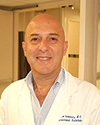|
Editor's
note: Reprinted from the 39th
annual Veithsymposium publication, Nov.
14-18, 2012, New York, NY. Schönholz is a
professor at MUSC.
Vascular interventional radiologist
Claudio Schönholz, M.D., Division of
Interventional Radiology, Department of
Radiology and Radiological Science,
joined several colleagues in November
2012 to celebrate the anniversary of a
revolution in vascular treatment
performed 20 years ago.
 Dr. Claudio
Schönholz Dr. Claudio
Schönholz
The first endovascular
treatment of an abdominal aortic aneurysm
(EVAR) in North America was celebrated
during the 39th annual VEITH symposium, a
conference supporting vascular surgeons
and other specialists recognizing new
developments in clinical practice and
research. The procedure was performed Nov.
23, 1992. Schönholz was joined by the
procedure team of Juan Parodi, M.D., Frank
J. Veith, M.D., Michael L. Marin, M.D.,
and Jacob Cynamon, M.D.
The story of how this
technique was developed and adopted in the
U.S. is a testament to the forward
thinking and collaborative investigators
who sought to expand the treatment options
available to their patients.
Parodi originated the
transformational surgical intervention
when he performed the first EVAR two years
earlier with Schönholz in Buenos Aires,
Argentina. The Montefiore Medical Center
in New York City was uniquely positioned
to be the first U.S. site to embrace this
new technology. Since the 1970s, the
vascular surgery group there had been
collaborating with interventional
radiologists to develop percutaneous
transluminal angioplasty as a supplement
to the various open surgical bypass
techniques routinely used to treat
patients with life-and-limb-threatening
vascular disease. As a result of this
collaboration, Veith had become a routine
participant in interventional radiology
meetings. At a meeting in January 1987, he
heard Julio Palmaz, inventor of the
balloon expandable stent used in coronary
arteries, give a talk about the potential
of intravascular stents.
Clearly, Palmaz and
Parodi had been thinking about the use of
stents and stent-grafts to treat abdominal
aortic aneurysms (AAA). Theoretical
discussion translated relatively quickly
to clinical reality, and by 1991, Parodi,
Palmaz, and Hector Barone had published
their landmark paper describing the first
of several cases in which they
successfully used EVAR.
These success stories
galvanized the Montefiore group, and when
a perfect candidate arose for the new
technique, they acted. In August 1992, a
76-year-old man who had numerous
comorbidities, including severe
oxygen-dependent pulmonary insufficiency,
presented to Marin with a 7.5-cm painful
and tender renal AAA. The patient's
comorbidities precluded the idea of open
surgery, which would be risky. Marin
consulted with Veith about other treatment
options, including the possibility of
taking advantage of the new endovascular
technique. As detailed by the participants
in an historical note in the Annals of
Vascular Surgery in 2005, discussions
ensued with Parodi. Marin and Veith even
offered to visit Buenos Aires to observe
the technique.
Because no such
operations were scheduled, Parodi was
invited to Montefiore. Before that
happened, however, Parodi was able to meet
with Marin at an interventional cardiology
meeting in Milwaukee, where he evaluated
the patient's X-rays and concluded that he
was a good candidate for EVAR.
Arranging the surgery
proved to be a complicated logistical
matter. The procedure was planned to
coincide with the 1992 Montefiore/Einstein
meeting, Parodi planned to attend. But
before this could take place, Johnson
& Johnson, the company that held the
Parodi and Palmaz patents, would have to
approve the use of a large Palmaz stent in
the U.S. The stent had not yet been
approved by the U.S. Food and Drug
Administration even for an Investigational
Device Exemption.
Parodi also requested
the participation of Schönholz, an
interventional radiologist with whom he
routinely worked, and Barone, who was
involved in assembling the various
components of the EVAR system.
A grant from the James
Hilton Manning and Emma Austin Manning
Foundation enabled the Argentinians to be
brought to the United States for the
duration of the symposium and the surgery.
Johnson & Johnson was leery about
allowing the procedure to be performed,
for fear it would jeopardize approval by
the Food and Drug Administration of the
Palmaz-Schatz coronary stents that were
then under review.
Persuaded by Veith and
Marin on compassionate grounds that the
operation should be done, however, the
company agreed that Parodi could operate
as long as he used his own stent setup
rather than the one for Johnson &
Johnson.
The long-awaited operation was performed
on Nov. 23, 1992. The team used a 22-mm
Dacron prosthesis sewn to a large
Palmaz-type stent, which was inserted via
a right femoral arteriotomy. Digital
fluoroscopic guidance was used, and the
stent was fixed to the proximal
nonaneurysmal aorta using a balloon to
expand the proximal stent.
Aneurysmal exclusion was demonstrated by a
variety of imaging modalities, but more
importantly, the prominent pulsation of
the aneurysm was no longer present and the
patient was able to be discharged a few
days later with his symptoms relieved. He
survived symptom-free for nine months, and
ultimately succumbed to cardiopulmonary
comorbidities.
Friday, Feb.
1, 2013
|



 Dr. Claudio
Schönholz
Dr. Claudio
Schönholz